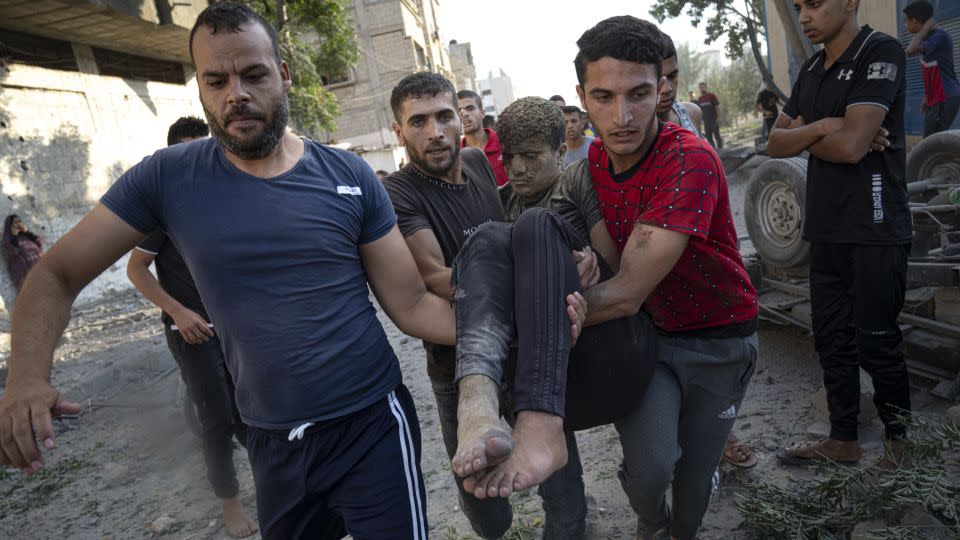Opinion: War didn’t look like this when the Geneva Conventions were written
- Oops!Something went wrong.Please try again later.
Editor’s Note: Mukesh Kapila is a former UN official who is Professor Emeritus of Global Health and Humanitarian Affairs at the University of Manchester. He is the author of “Against a tide of evil: How one man became the whistleblower to the first mass murder of the 21st century.” The views expressed in this commentary are his own. Read more opinion on CNN.
It took me a second to realize that the pinging was from bullets. It took longer to get over the shock that the United Nations lettering on the vehicle was making me a target.

This mad drive through Sarajevo’s infamous “sniper alley” was followed by an even more dangerous moment. An open dash into the hospital where I was triaging the sick and injured for evacuation.
Again, the huge Red Cross flag on the hospital roof did not stop our windows shattering into lethal shards that killed several around me. We were not the target – but we were in the way of artillery from a neighboring hilltop.
The siege of Sarajevo in the 1990s was my first exposure to urbanized warfare. It was to be followed with others in cities as far-flung as Kabul and Kigali, Huambo and Goma.
All of which come to mind as some 2.3 million residents of Gaza – living in one of the most densely-packed places in the Middle East – endure Israeli bombardment and siege, in response to massacres by Hamas.
Elsewhere across the globe, the bloodshed continues. There are daily Russian attacks on Ukrainian cities, epitomized by the 90% destruction of Mariupol. Sudan’s internal war has turned Khartoum into a living nightmare, and gangs in Port-au-Prince have created their own hell.
Wars in cities are not new. Jerusalem, by some estimates, has been attacked 52 times, besieged 23 times and destroyed twice over its long history. Britain and Germany pulverized each other’s cities in the Second World War while its most brutal battle over Stalingrad became stuff for movies. Beirut is still scarred by Lebanon’s civil war.

However, modern urban warfare sets new records of ruination because more than half of us live in built-up areas. Cities generate 80% of global GDP. Urban lifestyles depend completely on infrastructure for energy, water, healthcare, food supply, transport and communications.
Therefore, disrupting, destroying or controlling cities is central to war-making.
This is not illegal under the UN Charter but the concept of ’just’ war in international law requires protecting non-combatants.
In urban war, fighters and civilians intermingle
Often, the frontlines of urban conflicts cannot be clearly demarcated when fighters and civilians are intermingled. Protecting the latter is easier said than done amidst the general pandemonium. Besides, civilians – whether politicians and strategists, or cheerleaders on the sidelines – are implicated in wars, directly or indirectly.
Also, in the digital era of intelligence-led cyber warfare, distinctions between civilian and combatant is lost. As words are powerful weapons to provoke or disinform the other side, social media warriors proliferate.
Such belligerents are not at physical frontlines in military uniforms. They direct armed drones or unleash destructive computer viruses from nondescript apartments in ordinary communities.
Then there are activists and agitators seeking media attention to rally support or embarrass the enemy in the court of public opinion.
War has changed since the Geneva Conventions
These new-style warriors were unknown when the Geneva Conventions emerged over a century ago. In today’s whole-of-society conflicts, unarmed, non-uniformed combatants are unlikely to be accorded the traditional Geneva protections. Prevailing geopolitical fractures make it impossible to agree to new conventions.
So, when, for instance, Russian missiles hit residential blocks in Ukraine, which may host drone assembly, or Israeli jets demolish Gaza buildings with Hamas tunnels underneath them, the understandable outrage over the collateral killing of innocents could be equally directed towards those waging conflicts under civilian cover.
Explosive weapons in urban settings
The problem with rules prohibiting the disproportionate use of force is with titrating the violence. Over the decades, technology has improved targeting precision, but not at the pace of development of more powerful munitions with wide-area effects.
These types of explosive weapons were designed for traditional open battlefields and cause ferocious indiscriminate impact when unleashed in built environments.
That violates international humanitarian law and is contrary to a UN political declaration on explosive weapons in populated areas.
However, with fast-moving multiple targets in a chaotic cityscape, overwhelming force to achieve a quicker victory has compelling, if perverse, logic: to prevent the considerably greater casualties that occur in protracted warfare. Especially in asymmetrical conflicts where militias such as Islamic State and Hamas prefer the tactics of drawn-out violent attrition with even less respect for the rules of war.
Surgical strikes aimed at military targets with intent to minimize collateral damage to the surrounds are theoretically feasible. But mistakes often happen as with hospitals hit in Afghanistan and Yemen.
Prosecution for war crimes a rarity
Besides, who is doing the reckoning for war crimes? This is so rare that when Britain and Australia prosecute their soldiers for excesses in Iraq and Afghanistan, it makes headlines. Justice via the International Criminal Court is so slow that it makes no practical difference to ongoing wars. Thus, impunity rules.
Meanwhile, humanitarians are increasingly in the crossfire. Partly because trust is at an all-time low with the same nations funding aid as those providing the weapons to hurt. Humanitarian agencies struggle with neutrality and impartiality when coerced by one side or other. Aid is often a tool of war to be looted or diverted as in Ethiopia and Somalia.
Strong values-driven agencies such as the International Committee of the Red Cross and UN World Food Program struggle in Ukraine, Sudan and countless other places to balance principles with pragmatism. When they compromise to access those in desperate need, as in Syria or Libya, criticism is usual. That will also come in Gaza if humanitarian pauses and corridors are allowed.
The dilemma at the heart of urban warfare
What can urbanites do in such impossible circumstances? There is much talk of resilience, but this has limits when stockpiles do not outlast increasingly lengthy blockades as Gazans know, and safe rooms and bunkers cannot withstand direct assaults as Israelis discovered.
In 2021, after previous tensions around the Al-Aqsa Mosque in Jerusalem, at least 250 people in Gaza and 13 in Israel, died in 11 days of targeted Israeli air raids on Gaza. That figure was quickly eclipsed by this latest round of less-restrained bombardments. The final toll will be much greater. In truth, there are no good ways to conduct urban wars – but short ones are preferable. Unfortunately, that makes for high intensity warfare and heavy casualties
In Gaza, it means wishing success to external peacemakers. And courage to Gazan residents to resist the fanatic Hamas amidst them. Both the just Palestinian cause and Israel’s rightful security will benefit.
For more CNN news and newsletters create an account at CNN.com

